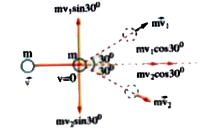A ball moving with a velocity of 6 m/s strikes an identical stationary ball. After collisions each ball moves at an angle of 30∘ with the original line of motion. What are the speeds of the balls after the collision?

Applying the law of conservation of momentum perpendicular to the initial line of motion:
0=mv1sin30∘−mv2sin30∘orv1=v2…(i)
Hence speed of both will be same after collision. Now along the line of motion:
mv=mv1cos30∘+mv2cos30∘.....(ii)
Putting equation (i) in equation (ii)
mv=2mv1cos30∘(or)v1=v√3=6√3=2√3m/s
Topper's Solved these Questions
- COLLISIONS BOOK - AAKASH SERIESCHAPTER - COLLISIONS EXERCISE - VERY SHORT ANSWER TYPE QUESTIONS
12 Videos
- COLLISIONS BOOK - AAKASH SERIESCHAPTER - COLLISIONS EXERCISE - NUMERICAL EXERCISE ( LEVEL 1)
18 Videos
- CENTRE OF MASSBOOK - AAKASH SERIESCHAPTER - CENTRE OF MASSEXERCISE - ADDITIONAL PRACTICE EXERCISE (PRACTICE SHEET (ADVANCED))
3 Videos
- ELASTICITYBOOK - AAKASH SERIESCHAPTER - ELASTICITYEXERCISE - Questions for Descriptive Answers
10 Videos
Similar Questions
A ball moving with a speed of 9ms−1 strikes an identical ball such that after the collision the direction of each ball makes and angle 30∘ with the original line of motion. Find the speeds of the two balls after the collision.
View SolutionA ball moving with a speed of 9m/s strikes an identical ball at rest, such that after the collision, the direction of each ball makes an angle of 30∘ with the original line of motion. Find the speeds of the two balls after collision.
View Solution
Knowledge Check
A ball moving with velocity of 6 m/s strikes an identical stationary ball. After collision each ball moves at an angle of 30∘ with the original line of motion. What are the speeds of the balls after the collision ?
A√32msecB3msecC2√3msecD√3msecA ball moving with a velocity of 6 m/s strikes an identical stationary ball. After collision each ball moves at angle of 30∘ with the original line of motion. Assuming that the collision is elastic, what are the speeds of the balls after the collision?
A√32m/s,2√3m/sB3m/s,2√3m/sC2√3m/s,2√3m/sD√3ms,√3m/sA ball , moving with a speed of 10√3m/s , strikes an identical stationary ball such that after the collision , the direction of each ball makes an angle of 30∘with the original line of motion. The speeds of two balla after the collision are , respectively.
A5m/s,10m/sB10m/s,5m/sC5m/s,5m/sD10m/s,10m/s
A ball moving with a speed of 9ms−1 strikes an identical stationary ball such that after the collision the direction of each ball makes an angle of 30∘ with the original line of motion. The speeds of two balls after the collision is
View SolutionA ball moving with a velocity 12m/s strikes an identical ball at rest.After collision both balls move in directions making 300 with original direction of motion.speeds of the balls after collision are (in ms−1) ?
View SolutionA ball moving with a speed of 9m/s strikes an identical ball at rest, such that after the collision, the direction of each ball makes an angle of 30∘ with the original line of motion. Find the speeds of the two balls after collision.
View SolutionA ball , moving with a speed of 10√3m/s , strikes an identical stationary ball such that after the collision , the direction of each ball makes an angle of 30∘with the original line of motion. The speeds of two balla after the collision are , respectively.
View SolutionA ball moving with a speed of 10 m s−1 strikes an identical ball such that after the collision the direction of each ball makes an angle 45∘ with the original line of motion. Find the speeds of the two balls after the collision.
View Solution
